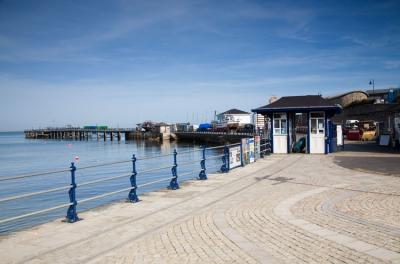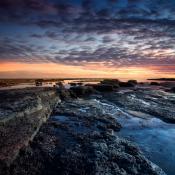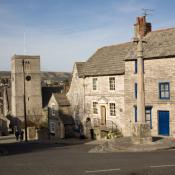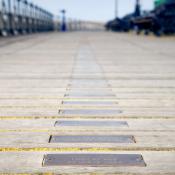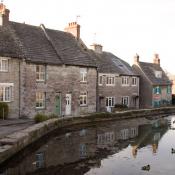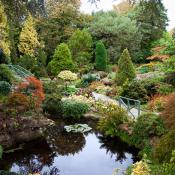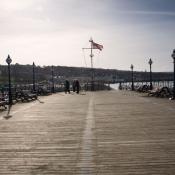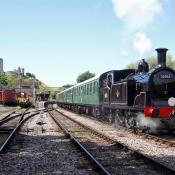
The town of Swanage is on the Isle Of Purbeck, a spur of land jutting out into the English Channel. The wide Swanage Bay gives good views to the Isle of Wight in good weather. To the north are chalk cliffs leading to Old Harry Rocks. There are more great views from Durlston Head to the south of the town.
50,000 years ago the Isle of Purbeck was still connected with the Isle of Wight. The earliest remains found in this area date from the Middle Stone Age and artefacts from about 2,500 BC have been found near Swanage itself. There is a long barrow on Nine Barrow Down in Purbeck and a stone circle at Rempstonem, believed to have been erected by the Beaker folk, of the Bronze Age. The round barrows on Nine Barrow Down can easily be seen from the valley below. These were burial chambers for the more important people of the day. They were often buried with certain artefacts, such as their drinking vessels – hence the name "beaker". There have been a number of archeological excavations in this area.
About 1,000 BC, the Celts arrived and settled to farm the area. introduced settled farming. The Romans arrived in Dorset soon after their invasion of Britain in 43 AD. The area had already been trading with Rome before the invasion and local industries, such as quarrying, continued under their supervision. Many Romano-British graves have been found in Swanage and various other artefacts have turned up over the years, from coins to building materials.
Roman Rule ended in the middle of the 5th century and over the next 400 years there were various barbarian invasions, destroying most of the Roman settlement. However, life continued here in spite of this. It is believed that there was a great naval battle here, against the Danes, in the time of Alfred the Great, but little is really known about this.
Until the early 19th century, Swanage remained a small fishing port, also shipping stone from nearby quarries. Following the success of Plymouth and Lyme Regis as seaside resorts, there was an attempt at this time to develop Swanage in the same way. This had limited success at first, but grew slowly during the 19th century. When the railway arrived in 1885 the resort really expanded, as can be seen from the many buildings dating from the late 19th and early 20th centuries.
Thomas Hardy stayed here in the winter of 1875, and described the town is in his novel “The Hand of Ethelberta”. He gives Swanage the name of “Knollsea” and says that “everybody in the parish who was not a boatman was a quarrier”.
Swanage is an ideal base from which to explore the eastern half of Dorset’s World Heritage Coastline. It is a small, attractive and friendly traditional seaside town, which nestles in a sandy bay at the foot of the Purbeck Ridge. The town boasts a fine selection of hotels and other accommodation, in addition to many bars, restaurants and cafés.
Swanage is an ideal venue for sailing and water sports and its safe bathing make it an ideal family centre. No dogs are allowed on the beaches in the season. The main beach has a gently shelving shore and a mile of sand and all local beaches are amongst the best in the UK. An added bonus for some is that the UK’s most popular naturist beach is here at Studland, owned and managed by the National Trust. The area has a wide range of attractions, many of which are open throughout the year.
The Victorian Swanage Pier was built in 1896, originally for use by the paddle steamer industry, to assist the transport of locally quarried Purbeck Stone by sea to Poole and London. The Swanage Pier Museum is sited on the pier and is a mine of interesting facts and displays about the local sea life and marine habitat, including information about the undersea ecology of the pier. It is open every day during the summer season and at weekend in the winter.
Swanage Railway operates on six miles of track between Swanage and Norden and is a good way in which to explore some of the lovely surrounding countryside. The more energetic can always do their exploring by mountain-biking along the Purbeck Hills. Of course, there is plenty to see around Swanage itself, with its parks, gardens, museums and shops, along the attractive winding streets.
There are various other places of interest around Swanage. Perhaps the best known is Corfe Castle, scene of one of the great battles of the English Civil War, ending in defeat for the Royalists. The site is believed to have originally been a Roman defensive position, but the castle is known to have been built as a wooden edifice in the 9th century. The present ruins are the remains of the 11th century rebuilt Purbeck Stone castle.
The nature reserve of Durlston Country Park on the coast south of Swanage is another place worth visiting, covering more than 260 acres of land. It is home to various species of animals, birds and reptiles. The reserve is popular with bird watchers and there are always sight-seers coming to watch the dolphins in the sea below the park.



